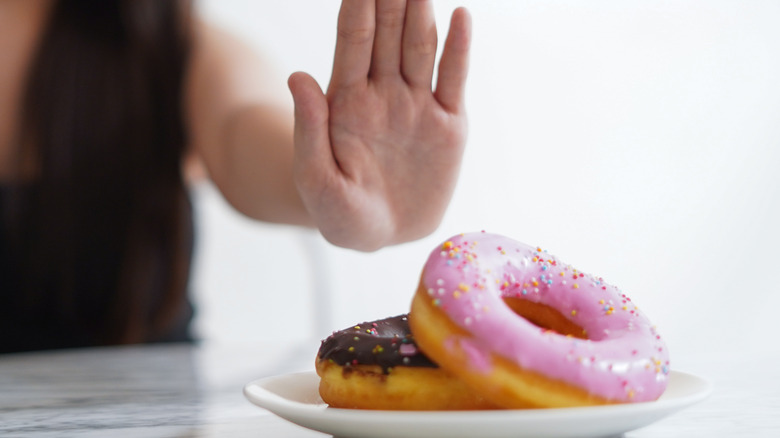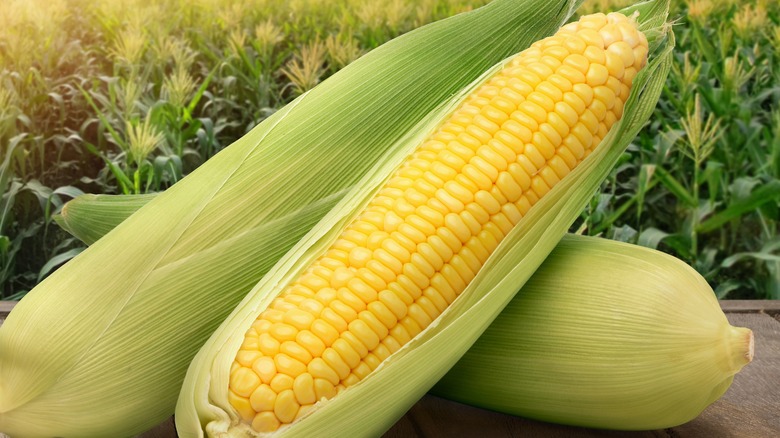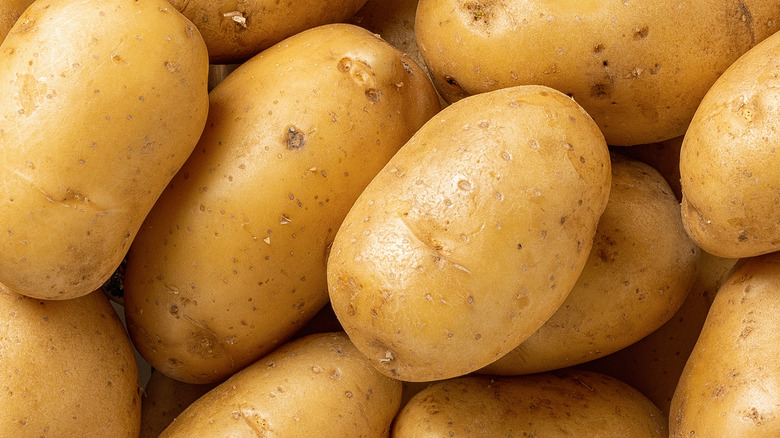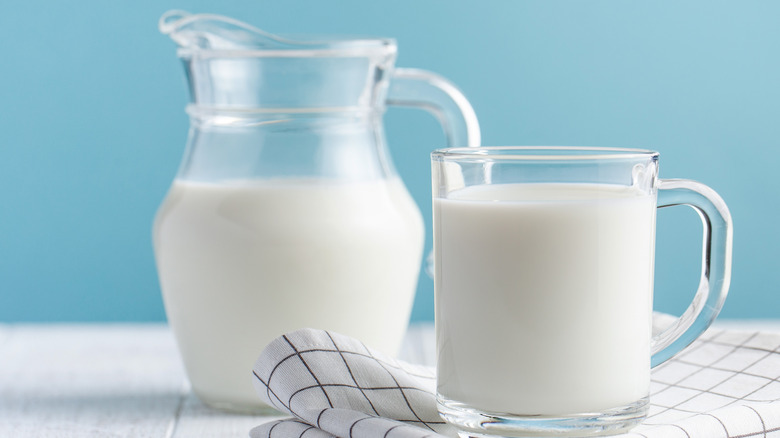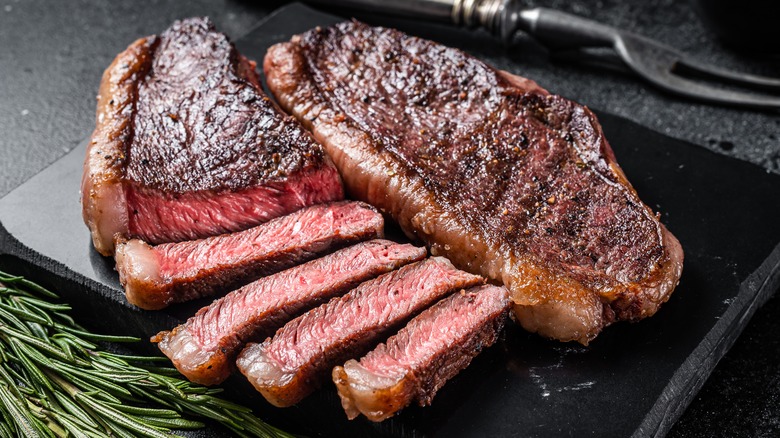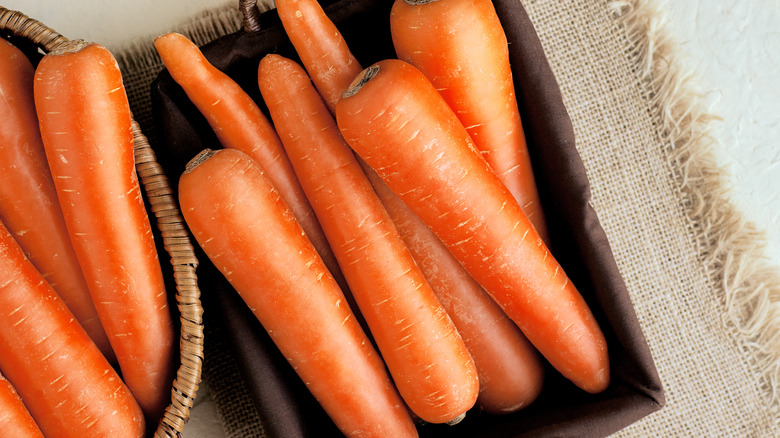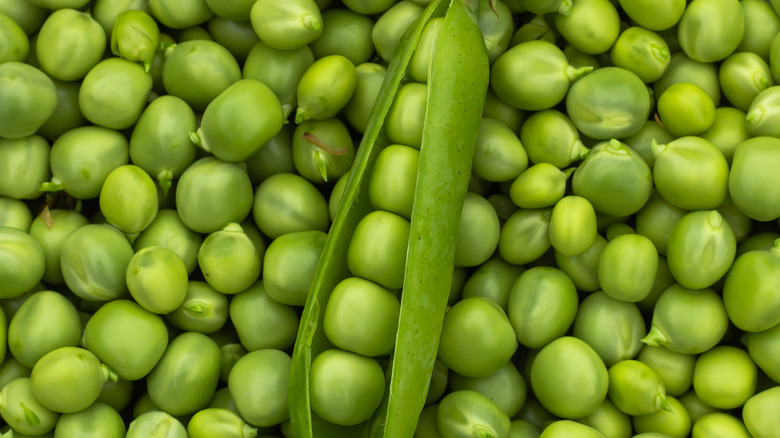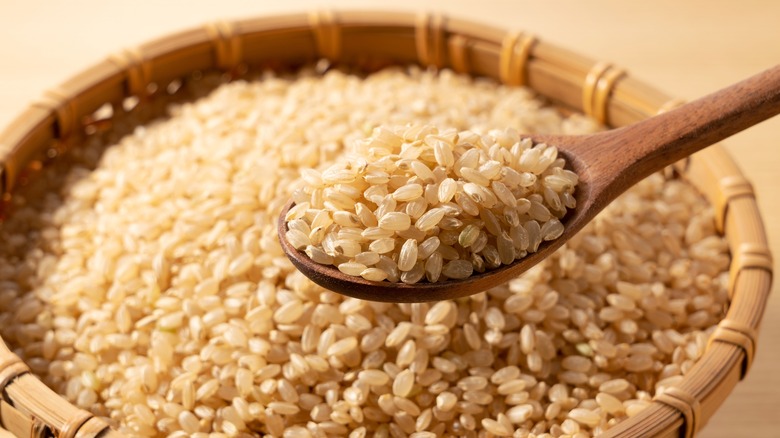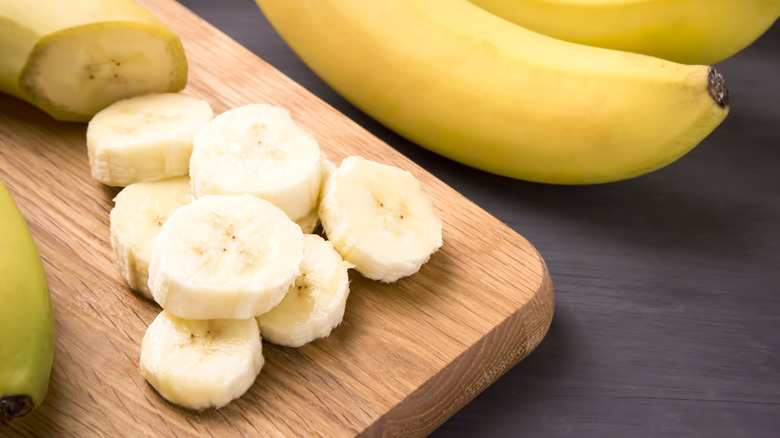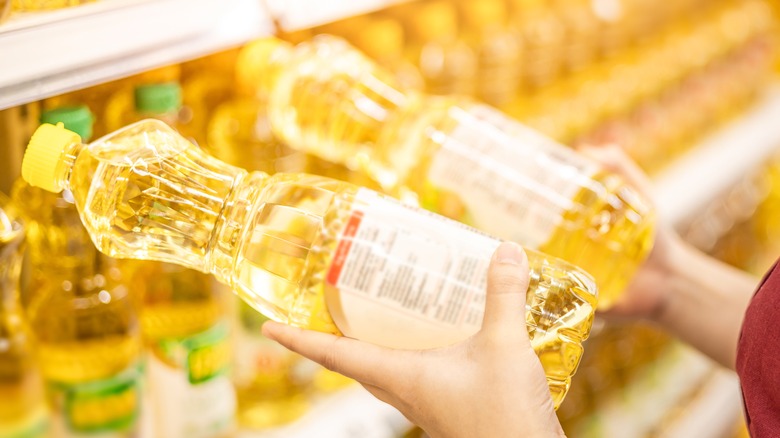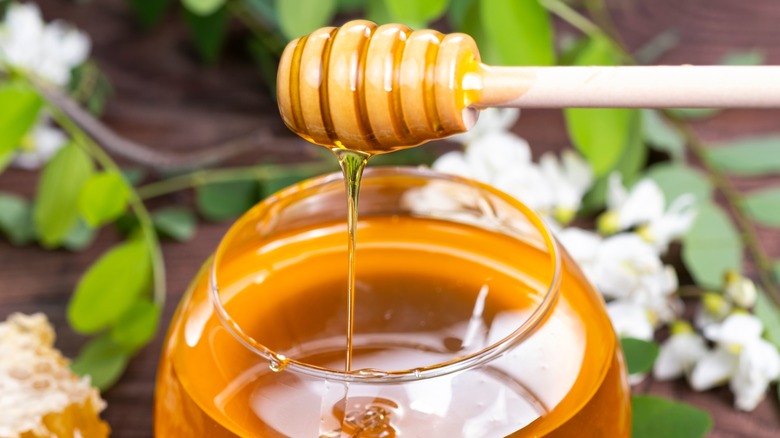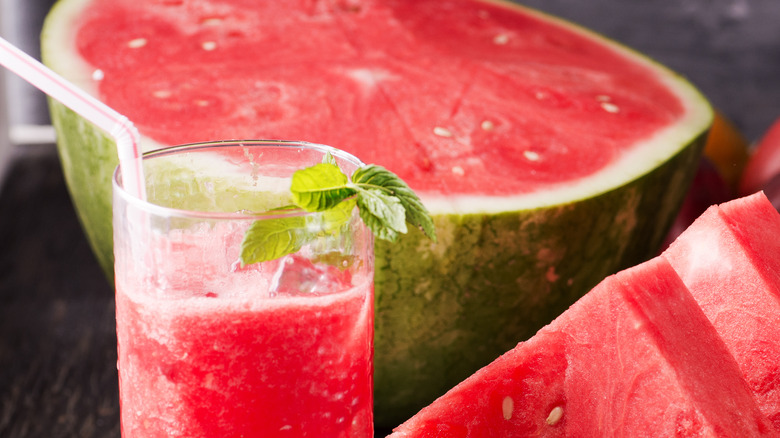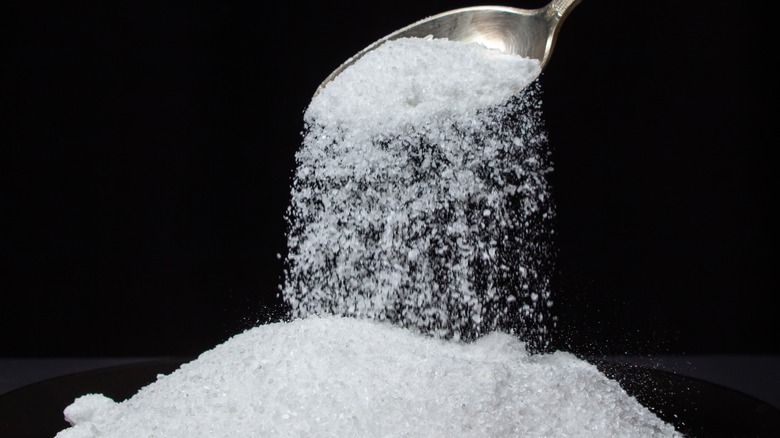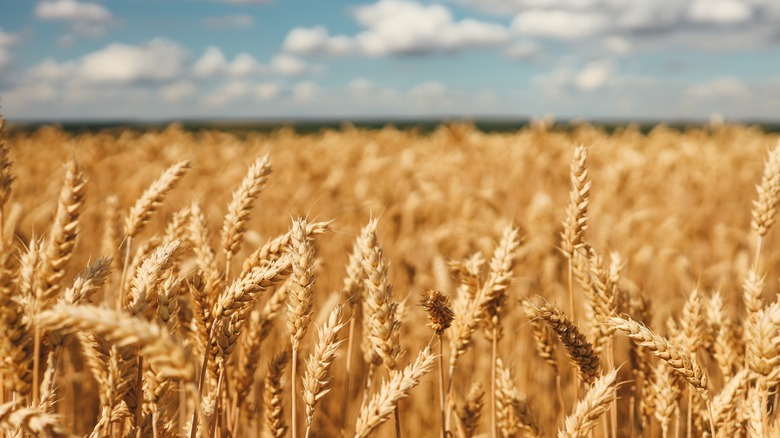Foods You Should Avoid When On A Low-Carb Diet
What exactly is a low-carb diet? This might seem like an easy question, but there are quite a few low-carb diet plans, each with their own rules and restrictions (via the Mayo Clinic). For example, generally speaking, low-carb diets involve reducing one's carbohydrates intake while increasing fat and protein consumption. But while some low-carb diets are very strict, for instance, about eating grains (which contain carbs), others allow them to some extent.
This can make it confusing to not only figure out what low-carb dieting options are available to you, but also what foods are all right if you're trying to follow one of these low-carb diets. And there's still one more possible complication: Low-carb diets aren't only used for weight loss. Sometimes, a person goes on one to lower their chances of developing other health problems, like type 2 diabetes. This can also impact which low-carb diet one chooses and which foods they either avoid or allow in portion-controlled amounts.
All of this can feel overwhelming, which is why we're going to discuss how certain foods are either off the menu or limited on different diets — both the ones that fit the definition of a strict low-carb diet plan to a tee, and others that are less strict but still get categorized as low-carb.
Corn
As MedicineNet explains, the keto diet (or ketogenic diet) involves limiting carbs so that your body will use stored fat for energy instead. Corn is a no-no (or a certainly very seldom) food on the keto diet because it is high in carbs. Avoiding consuming corn, however, isn't as simple as one might think. Sure, if you're at a buffet and you see corn on the cob, you can choose something else that's more keto-friendly. And if you're at the movies, it's easy to skip the popcorn. But it's not always that easy to determine whether or not a certain type of food contains corn. For example, as the Food Network notes, polenta is made from corn (cornmeal, to be exact). Additionally, grits are made from ground corn, per Food Network.
So if you're out to eat, don't be afraid to ask if something contains corn. You might also find that certain restaurants have keto-friendly options, or ways that they can adjust an item to make it fit into your keto diet plan.
Potatoes
Even if you're not that familiar with low-carb diets, you've probably heard of the Atkins diet. As Medical News Today explains, someone following an Atkins meal plan would consume small amounts of carbs while eating however much protein and fat they choose. Like the keto diet, the Atkins diet's goal is to put one's body into a state of ketosis, where their body uses stored fat for energy instead of glucose.
There are different phases of the Atkins diet. Certain foods are generally considered not good for this diet, or can only be eaten during certain phases of the diet (and only in small portions). For instance, in phase 1, someone on the traditional Atkins diet is only supposed to eat 20 grams of carbs on a daily basis. Because of this, starchy vegetables like potatoes are out in favor of low-starch vegetables like the leafy greens used in salads. However, by phase 3, an Atkins dieter can begin adding starchy vegetables back to their meals.
If you are considering the Atkins diet, keep in mind that there are different versions of the diet. For example, if only 20 grams of carbs is too restrictive, you might want to try Atkins 40, which allows the dieter to consumer 40 grams of net carbs per day. However, potatoes and other starchy vegetables are still restricted on this diet.
Dairy
As Dr. Lena Rydberg, an Internal Medicine physician at the Iowa Clinic in West Des Moines, explains, the paleo diet "is another low-carb, high fat, moderate-protein diet that can help keep you full." The basic premise behind the paleo diet is eating only foods that humans living in Paleolithic times would have consumed through hunting or gathering. So, while foods like fruits are allowed on the paleo diet, you have the option of making this diet as low-carb as you feel will serve your needs.
However, one big no-no on the paleo diet is dairy. Why? Those that follow the paleo diet believe that dairy (as well as other agricultural revolution foods) can cause a number of health issues like inflammation and obesity, per UC Davis Health. If you do decide (ideally under a medical professional's supervision) to try the paleo diet, there is a precaution when it comes to cutting dairy. The paleo diet can lead to not taking in enough vitamin D and calcium. According to the U.S. Department of Agriculture (USDA), 100 milliliters of 1% lowfat cow's milk has 125 milligrams of calcium and 42 IU (International Units) of vitamin D.
Alcohol
If you live in Miami, you're probably familiar with South Beach. And, yes, this place is where the South Beach diet gets its name (via the Mayo Clinic). To be clear, this diet isn't a strict low-carb one. In fact, the Mayo Clinic notes that it's "sometimes called a modified low-carbohydrate diet." That said, there is a keto version of it that is more carb-restrictive.
Like other diets on this list, the South Beach diet has different phases, each with their own rules and restrictions. For example, during phase 1, a South Beach dieter isn't supposed to drink any type of alcohol. Interestingly, there was some controversy over whether or not beer should be a no-no beverage on the South Beach diet. As the Chicago Tribune reported back in 2004, Anheuser-Busch Co. stated that maltose — a chemical called "the king of all sugars" in the book "The South Beach Diet" — is changed into alcohol and carbon dioxide during the fermentation process of beer. The book's author, Dr. Arthur Agatston, told the Tribune that most of the maltose is fermented out of beer, but also said that "... beer is fattening."
Additionally, Dr. Thomas Wolever, acting head of the department of nutritional science at the University of Toronto, told the Tribune that a beer can have as many carbs as two teaspoons of sugar, and he notes that low-carb beer is an option "if you're really trying to limit carbs."
Certain meats
It's easy to assume that low-carb diets have strict rules, but that's not always the case. As Stanford points out, the keto diet (which involves carb counting) is a low-carb diet, but so is the Mediterranean diet. As its name suggests, the Mediterranean diet involves eating foods traditionally consumed by people living in countries surrounding the Mediterranean Sea (via Healthline).
Unlike some of the low carb diets on this list, you're allowed to eat foods like fruits and whole grains on the Mediterranean diet. So yes, carbs aren't completely off the table, and you have control over of the amount of carbs you want to keep in your diet. You can also go really low-carb if you choose. However, there are certain foods the Mediterranean diet restricts. These include not just refined grains and beverages that contain sugar, but also processed meats like hot dogs, beef jerky, deli meats, and processed sausages.
Red meat is also something to "eat rarely" on the Mediterranean diet. (The Cleveland Clinic calls the Mediterranean diet a "plant-based diet," even though it does include white meats and fish.) A benefit to limiting or cutting red meat from one's diet is that it tends to reduce caloric intake. Additionally, there are concerns that consuming red meat might increase one's chances of developing high cholesterol, heart disease, and even cancer.
Carrots
MedicineNet puts carrots on the "... foods that you need to avoid" list when it comes to low-carb dieting. As Healthline explains, the Atkins diet, which has four phases, calls for limiting or avoiding eating carrots during phase 1 because they are high-carb vegetables. Carrots aren't as high in carbs as potatoes, for example (via Healthline). However, as the U.S. Department of Agriculture (USDA) points out, a cup of sliced raw carrots does have 9 grams of net carbs.
This brings us to another low carb diet: the keto diet. According to MedicineNet, the standard keto diet usually means consuming 70% fat, 20% protein, and 10% carbs. Carrots, which basically fall between leafy green vegetables (which are low-carb) and tubers like potatoes (which are higher in carbs than carrots) in terms of carb content, could easily fit into the keto diet. But that doesn't mean you can constantly eat them like Bugs Bunny. In fact, if you're on the keto diet, you'll probably want to keep your carrot consumption to a minimum.
Peas
The focus of the keto diet wasn't always about losing weight. According to WebMD, this diet, which goes back to the 1920s, was originally used to treat health issues like diabetes and epilepsy.
While there are different versions of the keto diet, eliminating or avoiding certain foods is an important aspect of it. Case in point: Starchy vegetables like peas aren't keto-friendly foods, as starch is a type of carb (per WebMD). if you're using the keto diet to lose weight, starchy vegetables tend to have more calories than non-starchy ones. Additionally, these vegetables are lower in fiber than non-starchy vegetables. Fiber can help one feel fuller, which can help with weight loss and management.
Okay, but what if you're on the keto diet to help manage your diabetes? Well, there's some interesting fine print when it comes to peas and blood sugar. When you eat foods that contain starch, that starch becomes glucose. So yes, starchy vegetables, can raise blood sugar levels. However, peas contain resistant starch, which doesn't elevate glucose levels because of how it's broken down by the body. In fact, the way our bodies break down peas can actually help us feel fuller. The bottom line: Peas might not be completely off the menu if you're on the keto diet, but they should be carefully portion-controlled.
Brown rice
When one thinks of dieting, they might imagine permanently cutting certain foods from their diet. But this isn't the case with the Atkins diet. As the Mayo Clinic explains, Atkins has four phases, and you can even opt to start at phases 2 or 3. However, if you do decide to do all four phases, you'll find that phase 1 is the most restrictive when it comes to carbs.
The traditional Atkins diet limits carbs to just 20 grams a day during the first phase. As US News & World Report explains, a half-cup of cooked brown rice exceeds that 20-gram limit. In fact, both the Mayo Clinic and US News & World Report note that one really shouldn't start reintroducing whole grains like brown rice until they're at phase 3 of the Atkins diet (the pre-maintenance phase). And even then, if the Atkins dieter finds that they're starting to regain their lost weight, they're advised to start cutting back on their carbs again until they reach their weight loss goal.
While low-carb diets in general can help with weight loss, they can have their downsides. As the Mayo Clinic notes, going low-carb may lead to constipation. And as MedicineNet points out, brown rice is a natural way to help with constipation since it's a whole grain.
Bananas
Imagine you start a fire in a fireplace and keep the fire burning by using wood. Now, imagine that you've run out of wood. Chances are you'd try burning a different fuel source. This is basically how the keto diet works. By eating considerably less carbs, your body is forced to switch to a different fuel source, which can result in burning fat. And as registered dietician Michelle Hyman told Women's Day, cutting most fruits from your diet can help you with your keto diet goals.
Of course, there's no way to talk about carb-loaded fruits without discussing bananas. As Healthline points out, these popular fruits are filled with carbs. Interestingly, unripe bananas have more carbs from starch than ripe bananas, which by comparison have more sugar. The U.S. Department of Agriculture (USDA) found that 100 grams of raw bananas that are ripe or slightly ripe contain 3.66 grams of starch. The same amount of overripe bananas, however, contains less than a gram of starch (via USDA).
Okay, but both sugar and starch are carbs, so does it really make a difference? Perhaps not in terms of the keto diet. However, as Healthline notes, unripe bananas have notable quantities of resistant starch, which can be good for digestive health. So, when you choose a low-carb diet and pick which foods to eliminate, remember to take all of your health needs into consideration.
Certain oils
The Mediterranean Diet puts the emphasis on plant-based foods, including the primary source of fat for the diet: olive oil (via eMedicineHealth). However, the Mediterranean Diet usually doesn't allow oils that are processed, refined, or hydrogenated.
Hydrogenated oil is when a manufacturer adds hydrogen to certain types of oil, like vegetable oil (per Medical News Today). As a result, the oil becomes solid fat at room temperature, and foods with this hydrogenated ingredient have a longer shelf life. One can find both fully hydrogenated and partially hydrogenated oils on the market. As the American Heart Association explains, partially hydrogenated oils are a major source of trans fats when it comes to processed foods. Trans fats have been shown to raise cholesterol, and might increase one's chances of developing health problems like type 2 diabetes, stroke, and heart disease.
While consuming olive oil is built into the Mediterranean diet and is a good source of antioxidants, you still need to check the food label when choosing a brand of olive oil (via Medical News Today). This is because some olive oils contain refined oil.
Honey
It's not a shocker that honey is on the "bad for low-carb diets" list. After all, as Everyday Health explains, not only is honey sweeter than granulated sugar, but it also has more carbs. It's also higher in calories, so this sweet treat might not be good for low-carb dieters trying to lose weight. As for the paleo diet, honey, as well as candy and sugar, are definitely not on the menu (via Everyday Health). And calories aside, those going on a low-carb diet to help with blood sugar concerns like diabetes might want to steer clear of honey.
Studies cited in Springer note that honey might help lower blood sugar and raise insulin levels, both of which in theory could be beneficial for diabetics. However, it's worth noting that they were conducted on animals, not humans. Additionally, the studies used honey in conjunction with diabetes medications. So, if you're on a low-carb diet or are just adjusting your diet for your diabetes, it's crucial to speak with a healthcare professional about whether or not you can have any honey (and how much is all right for you to consume).
Besides blood sugar concerns, Everyday Health cautions it's possible to have an allergic reaction to honey. If you're allergic to pollen or bees, you should be careful not just about eating honey, but also touching it.
Fruit juice
While the South Beach diet isn't a strict low-carb diet, it does have certain restrictions. For instance, phase 1 of the diet puts both fruit and fruit juices on the "off-limits" menu (via WebMD). With that said, there are some important details about fruit juice to keep in mind, especially once you reach phase 3 of the South Beach Diet.
According to Healthline, fruit juice and sugar-sweetened soda can contain similar amounts of sugar. Additionally, they have the potential to cause weight gain. Wait, does that mean fruit juice and soda are basically the same when it comes to one's health? Well, no. For one, their potential to cause weight gain is connected to calories and how much of them you drink. Also, drinking portion-controlled amounts of fruit juice might help lower the chances of developing health issues like heart disease and type 2 diabetes. Additionally, as research in Advances in Nutrition points out, fruit juice has nutrients that are usually not in soda.
While fruit juice is typically not allowed during the first phase of the South Beach diet, by phase three, it's up to you to pick not only what foods to eat, but also how much (via WebMD). Just remember to exercise good portion control, and make sure to check a particular juice's Nutrition Facts Label for ingredients like added sugar.
Salt
Anyone who grew up with "The Flintstones" will remember how they're called "the modern stone age family." And if the classic cartoon had been produced today, there's an excellent chance they would have brought up the paleo diet, since it's also referred to as the Stone Age diet or Caveman diet (via WebMD). But while it wouldn't be surprising to see a character on the "The Flintstones" throw a dash of salt on steaks, salt is a no-no if you want to go paleo.
According to Harvard, salt contains both sodium and chloride. And yes, sometimes the words "sodium" and "salt" are used interchangeably. For instance, the Centers for Disease Control and Prevention (CDC) have the word "salt" in the web address for an article titled "Top 10 Sources of Sodium." The items on that list are the sources of more than 40% of the sodium consumed by Americans on a daily basis. And while some (like pretzels) might seem obvious, others (like soups) may come as a surprise.
While it might seem easy to avoid salt on the paleo diet, there can be some challenges. For example, WebMD notes that eggs are allowed on the paleo diet. But eggs and omelets are on the CDC's list. Additionally, foods containing salt are sometimes used in omelets. Again, it's important to exercise good portion control, and to be aware of what's in your food.
Whole wheat bread
No list of foods that are bad for low-carb diets would be complete without mentioning bread. This is one way that low-carb dieting is notably different from Western diets, which tend to categorizes whole wheat bread as a healthy choice (via Livestrong). Keep in mind, however, that Western diets involve consuming more carbs (sometimes as much as 65%) compared to various low-carb dieting options, per the Mayo Clinic.
If you are used to a Western diet, you might think you can squeeze in a small amount of whole wheat bread on a low-carb diet. Well, let's crunch the numbers. If you're on the standard keto diet and are only consuming 20 net carbs daily, then according to Livestrong, making yourself a sandwich with two slices of whole wheat bread could exceed your carb allowance for the day. If you choose a low-carb diet that allows for more carbs (such as Atkins 40), then technically you could eat that sandwich (per Medical News Today). But just because you can, doesn't necessarily mean you should.
As Livestrong points out, if you use up all your carbs on whole wheat bread, that might mean you're not getting the right amount of fiber. In the case of the sandwich, adding fiber-rich leafy greens can help offset this problem. Remember: You can craft your low-carb diet based on your individual goals and needs.

